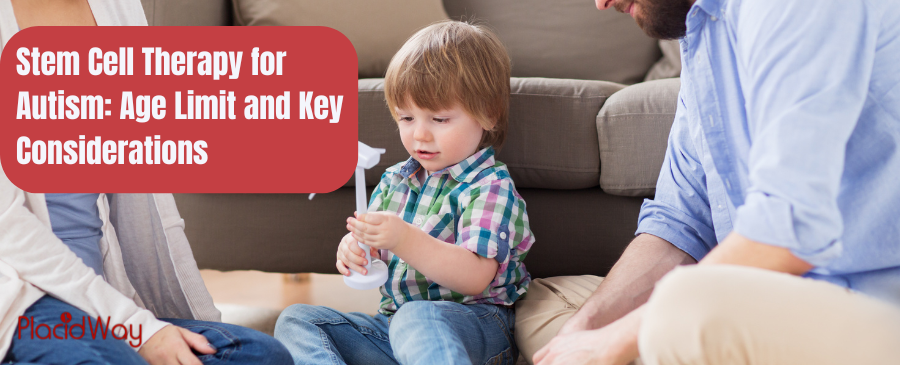Stem Cell Therapy for Autism: Ideal Age Limit & Key Insights

Stem cell therapy has emerged as a potential treatment option for children with autism, offering hope for families seeking alternative therapies. While stem cell therapy for autism is still being researched, many clinics around the world are offering this treatment with promising results. One of the key questions parents often ask is whether there is an age limit for this therapy and at what age it can be most effective. In this blog post, we will explore the age-related considerations for stem cell therapy in autism, its safety, and some common contraindications.
Is There an Age Limit for Stem Cell Therapy in Autism?
There is no strict age limit for stem cell therapy for autism, but studies suggest that early intervention often yields better results. Children between the ages of 2 and 8 are typically the best candidates, as their brains are still developing, and early intervention can have a more profound impact on their neural development.
- Early School Age (3–7 years): Many experts recommend starting stem cell therapy during early school years, ideally between 3 and 7 years old. This age range is considered optimal for stem cell treatment because children's brain plasticity is higher, which means their brain has a better capacity to adapt and form new connections.
- Non-Verbal IQ: Children with higher non-verbal IQs are thought to benefit more from stem cell therapy, as their cognitive ability may allow them to respond better to treatment and show more significant improvements in communication and social skills.
While early intervention is recommended, the treatment has shown positive results in older children as well. However, the success rate may be slightly lower compared to younger patients. Therefore, the decision on when to begin treatment should be based on a detailed assessment by medical professionals.
Contraindications to Stem Cell Therapy for Autism
Though stem cell therapy for autism is considered safe for many children with autism, there are specific contraindications that parents should be aware of before proceeding with treatment. These include:
- Being Under 1 Year of Age: Stem cell therapy is not recommended for infants younger than 1 year old. At such a young age, the nervous system is still developing in critical ways, and stem cell therapy may interfere with natural growth processes.
- History of Cancer: Children with a past or present cancer diagnosis are usually not considered candidates for stem cell therapy due to the risk of stimulating cancerous cell growth.
- Certain Types of Epilepsy: Children with epilepsy, especially those with severe forms, may not be eligible for stem cell therapy as it could potentially trigger seizures or make existing conditions worse.
Parents should always consult with a specialist to determine whether their child is an appropriate candidate for stem cell therapy.
Top Clinics in this Area around the World
|
Clinics |
Countries |
| Slovakia | |
| Dr. Omar Gonzalez Integra Medical Center |
Mexico |
|
Mexico |
|
|
Mexico |
|
|
Thailand |
Note: To book consultation with one of the best autism center in the world. Please contact with PlacidWay customer service team.
Success Rates of Stem Cell Therapy for Autism
The success rates of stem cell therapy for autism vary, but studies and clinical trials have reported success rates between 65% and 83%. These results are based on improvements in communication, social interactions, and a reduction in repetitive behaviors that are typical in autism spectrum disorder (ASD).
The earlier the treatment is started, the better the outcomes tend to be. This is largely because the therapy may enhance neural connections during a crucial stage of brain development in younger children. However, older children may also benefit from the therapy, depending on their individual condition and overall health.
Potential Side Effects of Stem Cell Therapy for Autism
Like any medical treatment, stem cell therapy for autism carries the potential for side effects, though they are generally mild and temporary. Some of the common side effects include:
- Allergic Reactions: In some cases, children may experience allergic reactions to the stem cell products used in the therapy.
- Fever and Headaches: Mild fevers and headaches can occur in the first few days after treatment as the body adjusts to the new cells.
- Injection Site Pain: Since stem cell therapy often involves intravenous injections, pain at the injection site is a common side effect.
- Gastrointestinal Disturbances: Some children experience nausea, vomiting, or other gastrointestinal issues after the treatment.
- Temporary Increase in Hyperactivity: In the first few months after treatment, children may exhibit increased hyperactivity or behavioral changes before improvements in their symptoms occur.
- Seizures: Although rare, seizures have been reported in some cases, especially in children with a history of epilepsy.
It’s important for parents to monitor their child closely following the procedure and to stay in regular communication with their healthcare provider.
Global Availability of Stem Cell Therapy for Autism
Stem cell therapy for autism is available in various countries around the world, including the United States, Mexico, Thailand, Colombia and other European nations. Some of the leading clinics conducting stem cell therapy for autism are involved in ongoing research, such as Mexstemcell clinic in Mexico.
In Germany, for example, stem cell therapy for autism has gained attention due to the country’s advancements in medical technology and research. Clinics offering this treatment often recommend it for children between 3 and 7 years old, aligning with the general consensus that early intervention is key.
The Importance of Early Intervention
Stem cell therapy for autism offers promising outcomes, particularly when administered at an early age. While there is no strict age limit, children between the ages of 2 and 8 generally show the best results. Early intervention during crucial developmental stages maximizes the potential for success, and the treatment is considered both safe and effective for many children.







.png)
.png)
.png)




